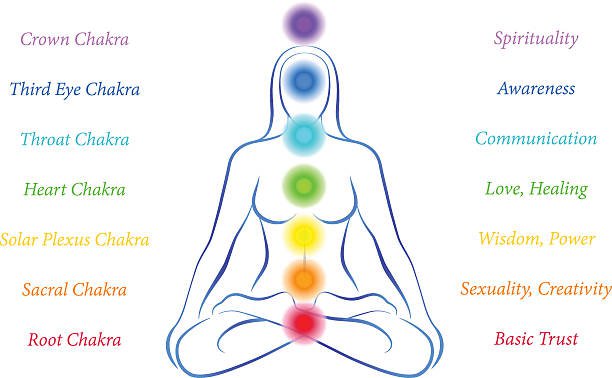
24 Mar 2021 HYN Himalayan Yoga Academy
Himalayan Yoga Academy presents essential content on the Science of Chakra and human endocrine system. The biological basis of the human body consists of 10 bodily systems that are associated with Body support. They are Muscular contraction, Digestion and Elimination, Reproductive, Lymphatic, Urination, Circulatory and Pulmonary, Endocrine, and nervous systems. According to chakra psychology our energy centers are directly related to the Endocrine System and Nervous System.
Energy Centres
1. Muladhara/1st Chakra:.
Root Chakra related to elimination and excretion. Associated sense organ- Nose is the sense organ of the first chakra. The sense of smell is connected to the early brain. Organ of action is Anus. The 1st chakra, the Muladhara – the root chakra, Movement here is the slowest – we use our anus but once a day. Is the anus a gland? Not by Western definitions. Maybe our analogy begins to break down as we reach the grossest level, but we can ask – is the anus important? Try to live without a proper functioning anus and all your other glands will be very unhappy.
2. Swadisthana Chakra/ 2nd Chakra:
Related to sex and reproduction. Ovaries (female), testicles (male) and also adrenal glands and hormones secreted it. Associated sense organ is tongue. Organ of action- Organ of action are genitourinary organs. Lower still, we come to the 2nd chakra: the svadhisthana – the center of water and sexuality. Here we find the reproductive glands. Here also we find a source of energy: body movement. When we dance, especially slow, tribal, sensual dancing, we stimulate these glands, and we notice the effect quite happily. Slow undulating movements are at very low frequencies: when we are seductive, we are slow.
3. Manipura Chakra/ 3rd Chakra:
Associated with digestion and absorption. The cortex of adrenal is the endocrine gland of the third chakra. Associated sense organs are eyes. Organ of action is digestive system. Responsible for maintaining bodily homeostasis. The glands and you will see another important gland: the pancreas – the source of insulin. It too is nourished with a certain form of energy. We are now at the 3rd chakra: the Manipura – city of jewels and power. Right above the pancreas is the diaphragm and it moves too: every breath we take causes the diaphragm to compress and release the pancreas. On average we breathe 18 times a minute, for a frequency of pressure on the pancreas of 1/3rd of a hertz.
4. Aanantha Chakra/ 4th Chakra:
Associated with circulation and respiration. It concerns to thymus gland. Sense Organ associated are fingertips. Organ of action is Skin and Storehouse is Diaphragm. The energy link is in fingertips and breathes.
5. Vishuddhi Chakra:
Associated to thyroid and parathyroid glands. The thyroid gland is most commonly associated with this chakra. The vishuddhi chakra is for clarity of communication between the mind, heart and soul and the ability to understand situations clearly without fear or doubt. Associated Sense Organ is Ears and Organ of action is Vocal chords
6. Aagya Chakra:
Pituitary Gland (both sense organ and organ of action) – Associated with the pituitary gland and the hypothalamus. This chakra is the master instructor, responsible for giving instructions to the whole body. If this cycle is blocked, there could be multiple hormonal imbalances.
7. Bindu Chakra/ Soma/Moon: Pineal Gland
8. Sahasrara Chakra/ Crown Chakra:
Hypothalamus of the brain associated Sense. Associated with the pineal gland, little is known about this chakra except that it responds to light. When the cosmic consciousness shines in the mind of humans, they attain truth.
Organ is Pituitary Gland and Organ of action is Pineal gland
Pituitary Gland:
Hormones secreted – Luteinizing Hormone (LH), Follicle-Stimulating Hormone (FSH), Thyroid Stimulating hormones (TSH), Oxytocin, Antidiuretic Hormone (ADH), Adrenocorticotropic Hormone (ACTH)
Pineal Gland:
Melatonin and serotonin.
Serotonin is a derived hormone that is responsible for sleep patterns in circadian and seasonal cycles.
Thyroid Gland:
- T3(Triiodothyronine), T4(thyroxin), TSH (Thyroid Stimulating hormone).
- They are tyrosine-based hormones that are primarily responsible for regulation of metabolism. T3 and T4 are partially composed of iodine.
- Thymus Gland: Responsible for immunity. Thymopoetin and thymosin. Hormones that assist in processes where T-cells differentiate into different styles.
- Thymosin- Accentuates immune response as well as stimulating pituitary hormone such as growth hormone.
Pancreas and liver:
Glands associated with pancreas:
- Insulin-like Growth Factor-1 (IGF-1)
- Angiotensinogen
- Thrombopoietin
- Hepcidin
- Betatrophin
Glands associated with Liver:
The most important hormone that the pancreas produces is insulin. Insulin is released by the ‘beta cells’ in the islets of Langerhans in response to food. Its role is to lower glucose levels in the bloodstream and promote the storage of glucose in fat, muscle, liver and other body tissues.
- Adrenals Gland: Steroid hormone like aldosterone.
- Testes and Ovaries
- Testerone(male) / Estrogen, progesterone(female), oxytocin.
The endocrine system plays a vital role in regulating bodily health. This system includes all the glands and hormones produced by it. These glands are controlled by the master gland and nervous system. Hormones released by glands are responsible for maintaining homeostasis, cellular metabolism, reproduction, respiration, growth and sexual development.
In Chakra Psychology as explained above chakra are energy centers in the body and they are parallel to the function of glands and glandular secretion (hyper-secretion, hypo-secretion and normal functioning).The hyper or hypo secretion of any glands might result in energy blockage/Chakra blockage and vice-versa. Each of the traditional l7 chakras and 21 microchakras, which enables the chakra to process information related to our thoughts, feelings, and behavior. When energy flowing in the chakra is blocked, our physical, emotional and psychological wellbeing is compromised. Through practice of Nada Yoga/sound and meditation one can achieve their psychological well-being.
